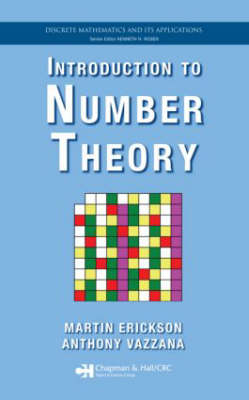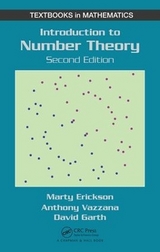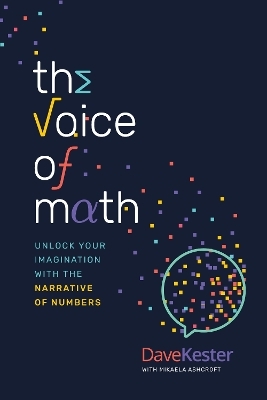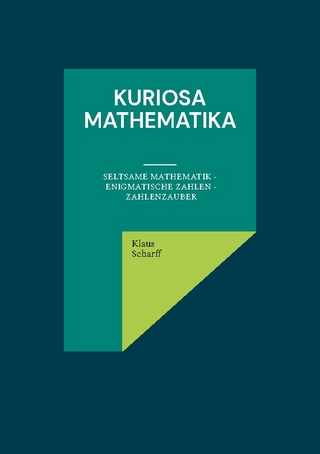
Introduction to Number Theory
Chapman & Hall/CRC (Verlag)
978-1-58488-937-3 (ISBN)
- Titel erscheint in neuer Auflage
- Artikel merken
One of the oldest branches of mathematics, number theory is a vast field devoted to studying the properties of whole numbers. Offering a flexible format for a one- or two-semester course, Introduction to Number Theory uses worked examples, numerous exercises, and two popular software packages to describe a diverse array of number theory topics. This classroom-tested, student-friendly text covers a wide range of subjects, from the ancient Euclidean algorithm for finding the greatest common divisor of two integers to recent developments that include cryptography, the theory of elliptic curves, and the negative solution of Hilbert’s tenth problem. The authors illustrate the connections between number theory and other areas of mathematics, including algebra, analysis, and combinatorics. They also describe applications of number theory to real-world problems, such as congruences in the ISBN system, modular arithmetic and Euler’s theorem in RSA encryption, and quadratic residues in the construction of tournaments. The book interweaves the theoretical development of the material with Mathematica® and Maple™ calculations while giving brief tutorials on the software in the appendices.
Highlighting both fundamental and advanced topics, this introduction provides all of the tools to achieve a solid foundation in number theory.
Truman State University, Kirksville, Missouri, USA Truman State University, Kirksville, Missouri, USA
Core Topics
Introduction
What is number theory?
The natural numbers
Mathematical induction
Divisibility and Primes
Basic definitions and properties
The division algorithm
Greatest common divisor
The Euclidean algorithm
Linear Diophantine equations
Primes and the fundamental theorem of arithmetic
Congruences
Residue classes
Linear congruences
Application: Check digits and the ISBN system
Fermat’s theorem and Euler’s theorem
The Chinese remainder theorem
Wilson’s theorem
Order of an element mod n
Existence of primitive roots
Application: Construction of the regular 17-gon
Cryptography
Monoalphabetic substitution ciphers
The Pohlig–Hellman cipher
The Massey–Omura exchange
The RSA algorithm
Quadratic Residues
Quadratic congruences
Quadratic residues and nonresidues
Quadratic reciprocity
The Jacobi symbol
Application: Construction of tournaments
Consecutive quadratic residues and nonresidues
Application: Hadamard matrices
Further Topics
Arithmetic Functions
Perfect numbers
The group of arithmetic functions
Möbius inversion
Application: Cyclotomic polynomials
Partitions of an integer
Large Primes
Prime listing, primality testing, and prime factorization
Fermat numbers
Mersenne numbers
Prime certificates
Finding large primes
Continued Fractions
Finite continued fractions
Infinite continued fractions
Rational approximation of real numbers
Periodic continued fractions
Continued fraction factorization
Diophantine Equations
Linear equations
Pythagorean triples
Gaussian integers
Sums of squares
The case n = 4 in Fermat’s last theorem
Pell’s equation
Continued fraction solution of Pell’s equation
The abc conjecture
Advanced Topics
Analytic Number Theory
Sum of reciprocals of primes
Orders of growth of functions
Chebyshev’s theorem
Bertrand’s postulate
The prime number theorem
The zeta function and the Riemann hypothesis
Dirichlet’s theorem
Elliptic Curves
Cubic curves
Intersections of lines and curves
The group law and addition formulas
Sums of two cubes
Elliptic curves mod p
Encryption via elliptic curves
Elliptic curve method of factorization
Fermat’s last theorem
Logic and Number Theory
Solvable and unsolvable equations
Diophantine equations and Diophantine sets
Positive values of polynomials
Logic background
The negative solution of Hilbert’s tenth problem
Diophantine representation of the set of primes
APPENDIX A: Mathematica Basics
APPENDIX B: Maple Basics
APPENDIX C: Web Resources
APPENDIX D: Notation
References
Index
Notes appear at the end of each chapter.
| Erscheint lt. Verlag | 30.10.2007 |
|---|---|
| Reihe/Serie | Textbooks in Mathematics |
| Zusatzinfo | 300 equations; 9 Tables, black and white; 26 Illustrations, black and white |
| Sprache | englisch |
| Maße | 156 x 234 mm |
| Gewicht | 860 g |
| Themenwelt | Mathematik / Informatik ► Mathematik ► Arithmetik / Zahlentheorie |
| ISBN-10 | 1-58488-937-3 / 1584889373 |
| ISBN-13 | 978-1-58488-937-3 / 9781584889373 |
| Zustand | Neuware |
| Informationen gemäß Produktsicherheitsverordnung (GPSR) | |
| Haben Sie eine Frage zum Produkt? |
aus dem Bereich



